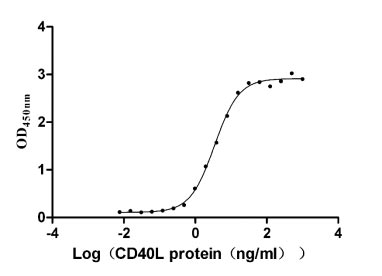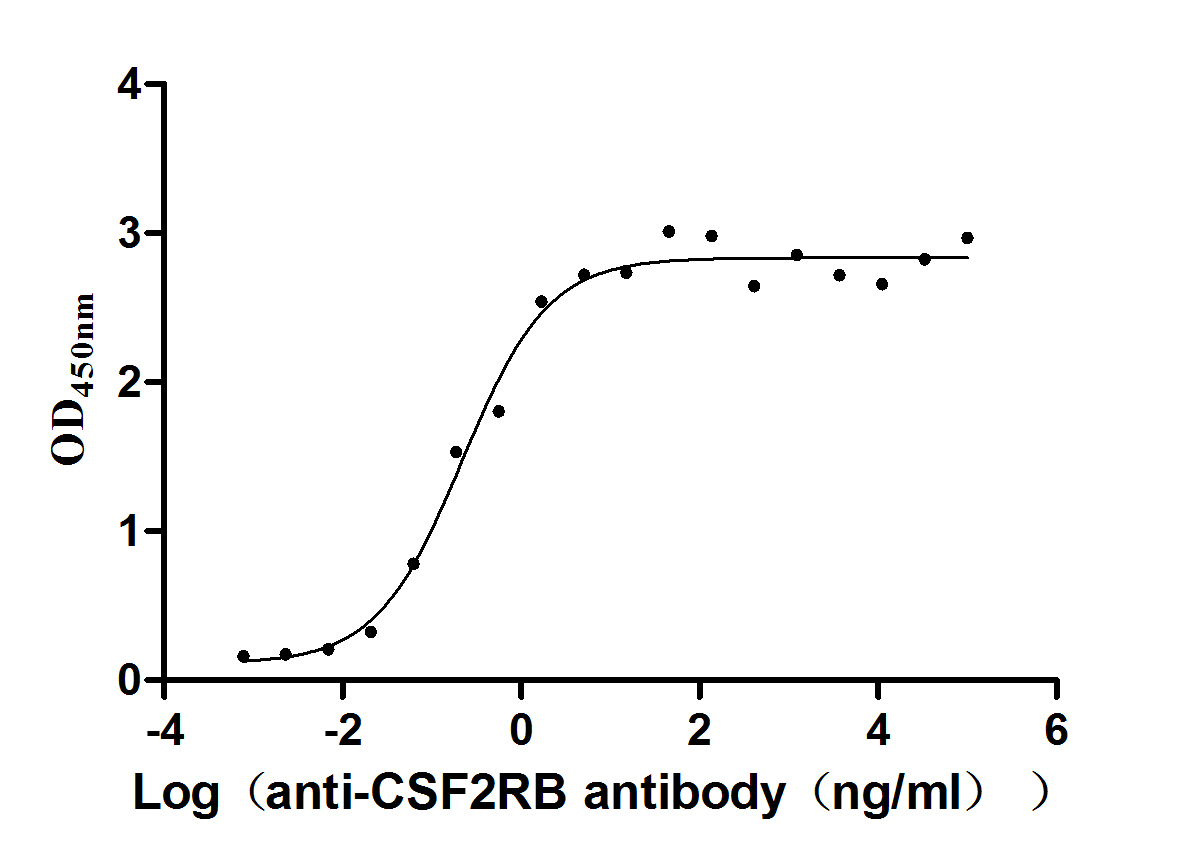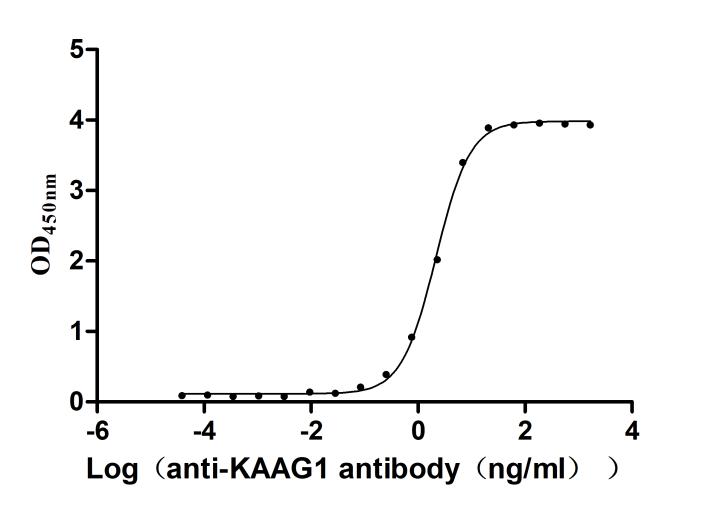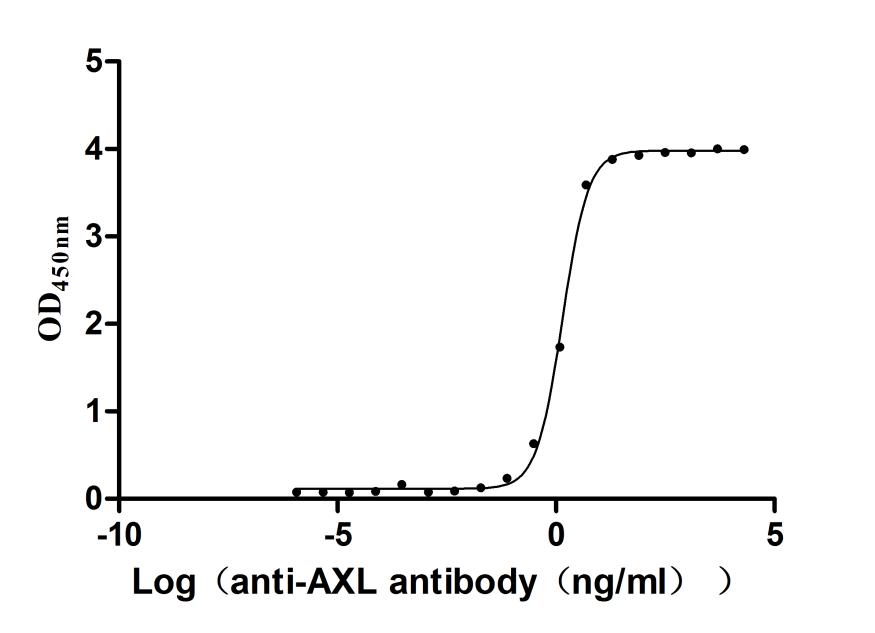Recombinant Human Lipopolysaccharide-binding protein (LBP)
-
货号:CSB-YP012775HU
-
规格:
-
来源:Yeast
-
其他:
-
货号:CSB-EP012775HU-B
-
规格:
-
来源:E.coli
-
共轭:Avi-tag Biotinylated
E. coli biotin ligase (BirA) is highly specific in covalently attaching biotin to the 15 amino acid AviTag peptide. This recombinant protein was biotinylated in vivo by AviTag-BirA technology, which method is BriA catalyzes amide linkage between the biotin and the specific lysine of the AviTag.
-
其他:
-
货号:CSB-BP012775HU
-
规格:
-
来源:Baculovirus
-
其他:
-
货号:CSB-MP012775HU
-
规格:
-
来源:Mammalian cell
-
其他:
产品详情
-
纯度:>85% (SDS-PAGE)
-
基因名:
-
Uniprot No.:
-
别名:BPI fold containing family D, member 2; Bpifd2; LBP; LBP_HUMAN; LBP1; Lipopolysaccharide binding protein; Lipopolysaccharide-binding protein; LPS binding protein; Ly88; MGC22233; OTTHUMP00000030965; RP23-407H16.4
-
种属:Homo sapiens (Human)
-
蛋白长度:Full Length of Mature Protein
-
表达区域:26-481
-
氨基酸序列ANPGL VARITDKGLQ YAAQEGLLAL QSELLRITLP DFTGDLRIPH VGRGRYEFHS LNIHSCELLH SALRPVPGQG LSLSISDSSI RVQGRWKVRK SFFKLQGSFD VSVKGISISV NLLLGSESSG RPTVTASSCS SDIADVEVDM SGDLGWLLNL FHNQIESKFQ KVLESRICEM IQKSVSSDLQ PYLQTLPVTT EIDSFADIDY SLVEAPRATA QMLEVMFKGE IFHRNHRSPV TLLAAVMSLP EEHNKMVYFA ISDYVFNTAS LVYHEEGYLN FSITDDMIPP DSNIRLTTKS FRPFVPRLAR LYPNMNLELQ GSVPSAPLLN FSPGNLSVDP YMEIDAFVLL PSSSKEPVFR LSVATNVSAT LTFNTSKITG FLKPGKVKVE LKESKVGLFN AELLEALLNY YILNTFYPKF NDKLAEGFPL PLLKRVQLYD LGLQIHKDFL FLGANVQYMR V
-
蛋白标签:Tag type will be determined during the manufacturing process.
The tag type will be determined during production process. If you have specified tag type, please tell us and we will develop the specified tag preferentially. -
产品提供形式:Lyophilized powder
Note: We will preferentially ship the format that we have in stock, however, if you have any special requirement for the format, please remark your requirement when placing the order, we will prepare according to your demand. -
复溶:We recommend that this vial be briefly centrifuged prior to opening to bring the contents to the bottom. Please reconstitute protein in deionized sterile water to a concentration of 0.1-1.0 mg/mL.We recommend to add 5-50% of glycerol (final concentration) and aliquot for long-term storage at -20℃/-80℃. Our default final concentration of glycerol is 50%. Customers could use it as reference.
-
储存条件:Store at -20°C/-80°C upon receipt, aliquoting is necessary for mutiple use. Avoid repeated freeze-thaw cycles.
-
保质期:The shelf life is related to many factors, storage state, buffer ingredients, storage temperature and the stability of the protein itself.
Generally, the shelf life of liquid form is 6 months at -20°C/-80°C. The shelf life of lyophilized form is 12 months at -20°C/-80°C. -
货期:Delivery time may differ from different purchasing way or location, please kindly consult your local distributors for specific delivery time.Note: All of our proteins are default shipped with normal blue ice packs, if you request to ship with dry ice, please communicate with us in advance and extra fees will be charged.
-
注意事项:Repeated freezing and thawing is not recommended. Store working aliquots at 4°C for up to one week.
-
Datasheet :Please contact us to get it.
相关产品
靶点详情
-
功能:Plays a role in the innate immune response. Binds to the lipid A moiety of bacterial lipopolysaccharides (LPS), a glycolipid present in the outer membrane of all Gram-negative bacteria. Acts as an affinity enhancer for CD14, facilitating its association with LPS. Promotes the release of cytokines in response to bacterial lipopolysaccharide.
-
基因功能参考文献:
- This study shows a remarkable reversal of amyloid fibrin formation by LBP addition to the plasma of Parkinson's Disease patients . PMID: 29494603
- Serum LBP levels are associated with arterial stiffness, independent of obesity and traditional cardiovascular risk factors, especially in men with type 2 diabetes. PMID: 28486964
- novel observation that sCD14 compared with lipopolysaccharide binding protein, offers a preferred target to ameliorate TLR especially TLR4-induced inflammation and insulin resistance in human obesity and metabolic syndrome PMID: 26880233
- LBP, an endotoxemia associated protein might be used as an inflammatory biomarker of both infectious and non-infectious origins in HCV-infected subjects PMID: 28107471
- Data show that after matching for gender, age, and body mass index (BMI), serum lipopolysaccharide-binding protein (LBP) does not improve prediction of the development of type 2 diabetes mellitus (T2DM) independently. PMID: 25753130
- The main findings of this study are that, in acute stroke patients, levels of LBP, IL-10, IL-6 and CRP show a different time course in patients with and without post-stroke infection. PMID: 25613713
- Serum LBP level is significantly elevated in polycystic ovary syndrome women and is associated with insulin resistance. PMID: 26799617
- LBP serves not only as an extracellular LPS shuttle but in addition facilitates intracellular transport of LPS. PMID: 26804480
- LBP level was not significantly different in neutropenic systemic inflammatory response syndrome patients and sepsis patients. PMID: 26046926
- Report increased secretion of Fetuin A, LBP and HMGB-1 from subcutaneous adipose tissue in metabolic syndrome. PMID: 25978344
- Low levels of microbial translocation marker LBP are associated with sustained viral response after anti-HCV treatment in HIV-1/HCV co-infected patients PMID: 25785448
- serum level elevated in late-onset neonatal sepsis in very low birth weight infants PMID: 25014514
- Adjusting for body mass index and waist circumference, LBP levels remained significantly increased in metabolic syndrome and increased with increasing numbers of MetS risk factors. PMID: 25063948
- study suggested that elevated plasma LBP was associated with an increased risk of developing MetS among middle-aged and older Chinese, especially in normal-weight individuals. PMID: 24906952
- In preterm neonates born to asymptomatic women with PPROM, LBP in cord blood at delivery is an excellent diagnostic biomarker of Fetal inflammatory response syndrome/funisitis with prognostic potential. PMID: 24335151
- report pre-ART IL-6 and LBP levels as well as IL-6, LBP and I-FABP levels during IRIS-event as potential biomarkers in TB-IRIS PMID: 24312369
- In childnre, LBP was independently associated with BMI and with measures of obstructive sleep apnea severity as well as with metabolic dysfunction, particularly insulin resistance as indicated by the homeostasis model assessment of insulin resistance. PMID: 24276451
- Suggest that the serum LBP concentration constitutes a reliable biologic marker for the diagnosis of a febrile urinary tract infection in children. PMID: 23463341
- Mutations in the lipopolysaccharide binding protein impair innate immunity. PMID: 24120359
- Serum LBP concentrations increased with age. Overweight, obesity, and having metabolic syndrome (particularly, low HDL cholesterol levels) were associated with higher LBP concentrations PMID: 23349936
- expression in oral keratinocytes is stimulated by Porphyromonas gingivalis LPS PMID: 22736337
- Human lipopolysaccharide-binding protein (LBP) and CD14 independently deliver triacylated lipoproteins to Toll-like receptor 1 (TLR1) and TLR2 and enhance formation of the ternary signaling complex PMID: 23430250
- LBP is a surrogate marker of microbial translocation in association with physical functioning of older adults. PMID: 22960476
- Association of lipopolysaccharide-binding protein gene polymorphisms with cerebral infarction in a Chinese population PMID: 22476641
- our study demonstrated that an elevated LBP level of >15000 ng/ml may serve as a biomarker for the prediction and monitoring of aGVHD. PMID: 22552880
- During the first 14 days of postoperative sepsis, LBP plasma concentrations showed a time course that was very similar to CRP with a high concordance in the pattern of day-to-day changes PMID: 21901123
- The availability of commercial methods for the automated measurement of the soluble CD14 subtype presepsin and lipopolysaccharide binding protein represent a challenge for the evaluation in clinical practice of reliable markers of neonatal sepsis. PMID: 21740312
- Aseptic trauma primes the innate immune system for the posttraumatic release of lipopolysaccharide binding protein and sCD14 PMID: 21722015
- Cytokine concentrations in amniotic fluid during the mid-trimester did not differ with parity or fetal gender. IL-6, IL-8, and LBP levels appeared stable with gestational week (GW), whereas GW significantly influenced TNF-alpha concentrations. PMID: 21702700
- LBP measurements performed shortly after preterm premature rupture of membranes, are not of value either in the prediction of newborn's infection, or in the prognosis of latency period duration. PMID: 21353369
- This study highlights the LBP rs2232596 and CD14 rs4914 polymorphisms as biomarkers for elevated colorectal carcinoma susceptibility in the Chinese Han population PMID: 21633598
- High LBP is associated with Crohn's disease. PMID: 20865702
- Elevated circulating LBP was associated with obesity, metabolic syndrome, and type 2 diabetes in apparently healthy Chinese. PMID: 20530747
- The association of the polymorphisms c.291C>T and c.613A>G suggest a role of LBP in the disease manifestation of infective endocarditis. PMID: 19560454
- Serial LBP serum measurements may offer a clinically useful biomarker for identification of patients with severe sepsis having the worst outcomes and the highest probability of developing sepsis-induced ARDS PMID: 19718443
- carboxyl-terminal domain of these closely related endotoxin-binding proteins dictates the route and host responses to complexes they form with endotoxin. PMID: 11773072
- a new and reliable infection marker after kidney transplantation PMID: 11976738
- Identification of single amino acid residues essential for the binding of lipopolysaccharide (LPS) to LPS binding protein (LBP) residues 86-99 by using an Ala-scanning library PMID: 11991204
- plasma factor LBP and cell surface receptor CD14 were necessary for LPS activation of p38, which was tightly associated with LPS priming of the PMN respiratory burst PMID: 12117913
- Besides a role in the detoxification of bacterial toxin present in the circulation, LBP-chylomicron complexes may be part of a local defense mechanism of the intestine against translocated bacterial toxin. PMID: 12538700
- innate immune recognition of LTA via LBP, CD14, and TLR-2 represents an important mechanism in the pathogenesis of systemic complications in the course of infectious diseases brought about by Gram-positive pathogens. while TLR-4 and MD-2 are not involved. PMID: 12594207
- Single nucleotide polymorphism of the LBP gene is not assciated with complicated sepsis after trauma. PMID: 12615620
- data support the hypothesis that lipopolysaccharide binding protein can inhibit cell responses to lipopolysaccharide(LPS) by inhibiting LPS transfer from membrane CD14 to the Toll-like receptor 4-MD-2 signaling receptor PMID: 12754215
- plays an essential role in the innate immune response to Gram-positive pneumococci PMID: 12932360
- In critically ill neonates aged over 48 h and children lipopolysaccharide binding protein is a better marker than procalcitonin, interleukin-6 and C-reactive protein. PMID: 15127192
- Dual role of LBP and CD14 in initiation of proinflammatory signaling and clearance or neutralization of LPS. PMID: 15618154
- studies suggest that SP-A could contribute to modulate Re-LPS responses by altering the competence of the LBP-CD14 receptor complex PMID: 15932345
- LBP mediates the fusion of lipid membranes and LPS aggregates. PMID: 16303759
- Human pulmonary LBP acts as an important modulator of the LPS response in the respiratory tract in vivo. PMID: 16493079
- Significantly elevated serum concentrations of LBP and sCD14 are found in severe sepsis patients. PMID: 16512634
显示更多
收起更多
-
亚细胞定位:Secreted. Cytoplasmic granule membrane.
-
蛋白家族:BPI/LBP/Plunc superfamily, BPI/LBP family
-
组织特异性:Detected in blood serum (at protein level).
-
数据库链接:
HGNC: 6517
OMIM: 151990
KEGG: hsa:3929
STRING: 9606.ENSP00000217407
UniGene: Hs.154078
Most popular with customers
-
Recombinant Human Tumor necrosis factor receptor superfamily member 5 (CD40), partial (Active)
Express system: Mammalian cell
Species: Homo sapiens (Human)
-
Recombinant Human Tumor necrosis factor ligand superfamily member 9 (TNFSF9), partial (Active)
Express system: Mammalian cell
Species: Homo sapiens (Human)
-
Recombinant Human Cytokine receptor common subunit beta (CSF2RB), partial (Active)
Express system: Mammalian cell
Species: Homo sapiens (Human)
-
Recombinant Human Transferrin receptor protein 1 (TFRC), partial (Active)
Express system: Mammalian cell
Species: Homo sapiens (Human)
-
Recombinant Human Interleukin-2 receptor subunit alpha (IL2RA), partial (Active)
Express system: Mammalian cell
Species: Homo sapiens (Human)
-
Recombinant Human Kidney-associated antigen 1(KAAG1) (Active)
Express system: E.coli
Species: Homo sapiens (Human)
-
Recombinant Human Tyrosine-protein kinase receptor UFO(AXL),partial (Active)
Express system: Mammalian cell
Species: Homo sapiens (Human)



















